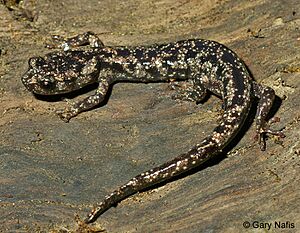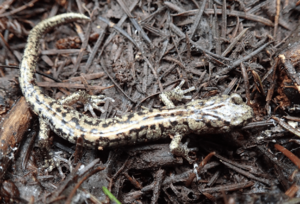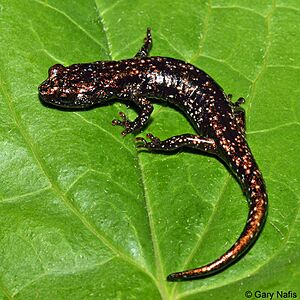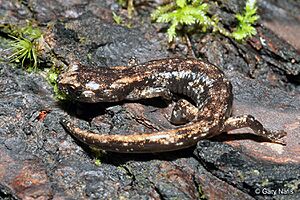Wandering salamander facts for kids
Quick facts for kids Wandering salamander |
|
|---|---|
 |
|
| Conservation status | |
| Scientific classification |
The wandering salamander (Aneides vagrans) is a species of salamander found in northern California in the United States and in British Columbia, Canada. It's a small, slender amphibian that belongs to a group of salamanders called Plethodontidae. These amazing creatures have some cool abilities, like being able to glide through the air if they jump from a tree.
Unlike many salamanders that stay close to the ground or water, this species loves to climb and spend time high above the forest floor. They are sometimes called "lungless salamanders" because they breathe mainly through their skin and the lining of their mouths.
Their natural habitat is temperate forests.
Contents
What do they look like?
- Size
They are quite slender. From their snout (nose) to the base of their tail, they usually measure about 80 millimetres (which is about 3.1 inches). If you include their tail, their total length can reach around 130 millimetres (about 5.1 inches).
- Color
Their main color can be anywhere from brown to a light grey. They often have lighter, bronze-grey patches or spots scattered across their back. Young Salamanders: When they are young, they have a neat coppery-bronze stripe running down their spine.
- Grooves
If you look closely at their sides, you'll see little vertical grooves called costal grooves. Wandering salamanders usually have between 14 and 16 of these grooves, with 15 being the most common number.
- Head Shape
The shape of their head can tell you if it's a male or female! Males tend to have a broader, more triangular head than females.
- Special Grooves
Like other salamanders in their family, they have tiny grooves between their nostrils and mouth. These are called naso-labial grooves and help them "smell" or sense chemicals in their environment, which is super important for finding food and knowing what's around them.
The wandering salamander has some amazing body parts that help it live its life high up in the trees:
- Long legs and toes: They have relatively long legs and toes. Their toes have special expanded pads at the ends that are shaped kind of like squares. These pads help them grip surfaces when climbing vertically and are also useful when they are gliding.
- Prehensile tail: Their tail is round and can be used to grasp things, like branches. It also helps them steer and control their movement when they are falling or gliding through the air.
It's interesting to know that the wandering salamander looks quite similar to another species called the clouded salamander (Aneides ferreus). For a long time, scientists thought they were the same species!
Distribution
The wandering salamander has a very unusual distribution, meaning the places where it lives are quite far apart.
One group of wandering salamanders lives in northern California. You can find them in counties like Siskiyou and Del Norte, and south along the coast through the northwestern part of Sonoma County.
The other main group lives far away on Vancouver Island in Canada, and some of the smaller islands nearby.
This "disjunct distribution" (meaning the populations are separated by a large distance where the species doesn't live) is a bit of a mystery. Scientists aren't completely sure why they live in these two specific places so far apart. There are a few ideas, but none have been fully proven:
One idea is that the salamanders were accidentally brought to Vancouver Island a long, long time ago, maybe in the 1800s. People in Canada were importing large amounts of tanoak bark from California to use in the leather tanning industry. Wandering salamanders like to hide in bark crevices. It's possible that some salamanders were hiding in the bark when it was shipped from California to Vancouver Island and survived the journey. There were several leather tanning businesses on Vancouver Island before the first wandering salamander was officially recorded there in 1906. This theory suggests they then spread out across the island.
Another idea is that the salamanders traveled naturally. There's a strong ocean current called the Davidson Current that flows north along the Pacific coast. During the winter, this current can carry logs and other floating material from California towards Vancouver Island. It's possible that salamanders hitched a ride on these natural "rafts" and made the long journey across the ocean.
Before scientists realized the California and Vancouver Island salamanders were a separate species from the Oregon ones (which happened in 1998 based on genetic studies), there was a theory that glaciers caused the split. The idea was that the species used to live in a continuous area, but glaciers during the ice ages pushed them into separate safe spots (called refugia) in California and Vancouver Island. However, if this were the case, you might expect the two populations to have become more genetically different over such a long time, but their genes are actually quite similar. This makes the glaciation theory less likely as the main explanation for their current distribution.
So, while we know where they live, the why behind their separated homes is still a cool puzzle for scientists,
Habitat
Wandering salamanders can be found in different types of places, from right near the ocean all the way up to areas 1,700 metres (about 5,600 feet) high.
They are famous for living in the forest canopy, which is the upper layer of branches and leaves in a forest. They can climb incredibly high, sometimes up to 24 metres (about 80 feet) into the branches of trees. They've even been found living way up in the crowns (the very tops) of giant coast redwood trees. They seem to like hanging out in mats of ferns that grow in the crooks of redwood branches.
While they love the trees, you can also find them closer to the ground in moist places. They might hide in rotting logs, cracks in bark, old tree stumps, or under rocks. They seem to prefer being inside bark on a log rather than just under loose bark on the ground.
These salamanders seem to have very small home areas and usually don't travel very far from where they live.
Behavior
Like most salamanders, their activity depends a lot on how much moisture is around. They are more likely to be active and out and about when it's rainy or the air is very humid. On Vancouver Island, they are most active during the spring, summer, and fall. They probably become dormant (like a deep sleep) during the cold winter months. In California, where the summers can be very dry and hot, they are usually most active during the rainy winter months and less active during the summer.
Wandering salamanders often use their nose to explore, tapping it on the ground or on other salamanders. When they are alert, they raise their head. Sometimes, they rub their nose or belly on the ground, which might be a way of leaving their scent behind. However, unlike many other salamanders, they don't seem to use their droppings (fecal pellets) to mark their territory.
On Vancouver Island, wandering salamanders seem to be less territorial than some other types of salamanders. Studies in labs showed that they didn't avoid places where other salamanders (of their own species or different species) were already hiding, except for rough-skinned newts. Rough-skinned newts have toxins in their skin, which is probably why the salamanders avoid them.
Aggressive fights between wandering salamanders are less common compared to similar species. Behaviors that other salamanders use to show they are ready to fight (like raising their bodies or snapping their jaws) don't seem to be linked to fighting in Vancouver Island wandering salamanders. However, when fights do happen, it's usually between males. They might try to hold each other down, push, or chase each other. When they want to look threatening, they raise their whole body off the ground, straighten their legs, and arch their back and tail.
Scientists haven't studied territorial behavior as much in the California populations of wandering salamanders, so we don't know if they act the same way as the ones on Vancouver Island.
Amazing abilities
These salamanders have some truly remarkable skills that help them survive in their tree-dwelling world.
Gliding
This is perhaps their most famous ability. If a wandering salamander is disturbed while high up in a tree, it might leap off. But instead of just falling, they can actually control their descent. Scientists have studied them in wind tunnels and found that they can adjust their body position (like tilting or turning) to stay upright and stable in a "skydiving" pose. This posture involves spreading their legs and feet wide and angling their tail upwards. This helps slow down their fall. Their large feet and long toes seem to help create drag, further reducing their speed. Their long legs also position their feet away from their body, which might help them steer in the air. They can even wiggle their body and tail in a wavy motion, similar to some lizards that live in trees, which allows them to glide in a controlled way. This means they can often land safely on the trunk or a branch of a tree, sometimes even the same tree they jumped from, instead of crashing all the way to the ground.
Climbing
Their toes are specially adapted for climbing. The square-shaped ends of their toes have a space inside that they can quickly fill or empty with blood. Changing the shape of their toe like this might help them get a better grip and stick to surfaces. When these spaces are filled with fluid, they might also act like tiny shock absorbers, helping to soften their landing after a jump. Some tree frogs have similar structures for softening falls. Like many animals that climb trees, wandering salamanders also have curved toes, although scientists aren't sure if this shape actually makes their grip stronger. Interestingly, unlike some other climbing salamanders, they don't seem to rely on producing sticky slime (mucus) to help them stick to surfaces.
Reproduction
Breeding happens in the spring and early summer. The female wandering salamander lays a clutch of eggs, usually between 6 and 9 of them. She hides the eggs in a safe spot. These spots can be on the ground, like under logs, or surprisingly, high up in trees, sometimes 30–40 metres (about 98–131 feet) above the ground. Adult salamanders have been seen guarding their eggs while they develop.
One cool thing about wandering salamander eggs is that they hatch directly into tiny versions of the adult salamander. Unlike many other amphibians (like frogs or some salamanders) that hatch into a larval stage that lives in water (like tadpoles), wandering salamanders skip this step entirely.
Diet
Wandering salamanders aren't picky eaters; they eat a variety of small invertebrates.
Their diet includes things like ants, mites, adult beetles and their young (larvae), snails, tiny jumping insects called springtails, and woodlice (sometimes called roly-polies).
Based on studies, ants seem to be the biggest part of their diet, followed by beetles and springtails.
Status
The wandering salamander is listed as Least concern in the IUCN Red List of Threatened Species. This means they are not currently in immediate danger of disappearing completely. However, their populations are declining, which means there are fewer of them around than there used to be.
Even though they are currently listed as Least Concern, it's important to protect their forest homes to help their populations recover and thrive.
Threats
The main reason their numbers are going down is habitat loss. This happens because of things like:
- Logging
When forests are cut down, especially using intensive methods where trees are removed frequently, it takes away the trees where the salamanders live. Over time, logging also reduces the amount of old logs and stumps on the ground, which the salamanders use for shelter and laying eggs. While they might do okay right after logging, their numbers can drop later as the remaining wood decays and isn't replaced.
- Land clearing
Forests are also cleared for farming (agriculture) and building houses and other buildings (residential development). This directly destroys the places where the salamanders live.
- Climate change
Changes in climate, like droughts, are also a potential threat. If their habitat becomes too dry, it's harder for them to survive because they need moisture to breathe through their skin.
- Fungus
There is also a fungus called Batrachochytrium salamandrivorans that can make salamanders sick. While this fungus hasn't been confirmed in North America yet, scientists are keeping an eye on it because it could potentially affect wandering salamander populations in the future.






